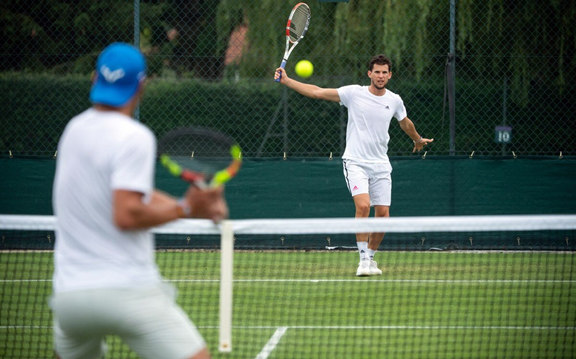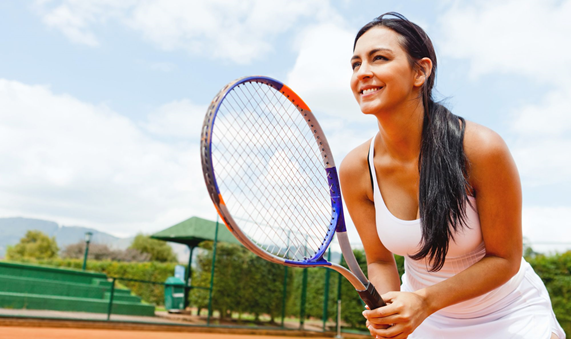- Molly O’Callaghan, a 19-year-old swimmer from Australia, etched her name in the annals of swimming history with a remarkable performance in the Women’s 200m Freestyle event
- Akshay Bhatia, 21, Wins his First PGA Tour Title at the Barracuda Championship
- Bruno Fernandes Replaces Harry Maguire as New Man Utd Captain
- Lionel Messi Surprises Teammate in group chat ahead of Grand Unveiling
- Man Utd Sign Keeper Andre Onana from Inter
10 Things to Consider While Buying a New Tennis Racket
- Updated: July 20, 2021
- 803

As a tennis player, the most important thing to consider when buying a new tennis racket is what your skill level is and how you play. If you are an intermediate or professional tennis player, it’s best to buy something with more power and control. However, if you are beginner-intermediate or just someone who likes to hit for fun once in a while, then an easier racket would be better suited for you.
There are also a few additional factors that need to be considered, such as grip size (if there’s no pre-existing preference), the weight of the racket, stringing pattern, etc. Similarly, there are several other things that you need to consider before making any purchases so that players can get the most out of their money! So, let’s get started.
- Know your skill level: The most important thing to consider when buying a new racket is what your skill level is. Beginner? Intermediate? Advanced player? Knowing which one you are will help narrow things down immensely and make the decision-making process much easier for you! For instance, if you are just starting out, a racket with more power and control will be your best bet. However, if you are an advanced player or someone who likes to hit for fun once in a while, then it’s better to buy something that is easier.
- Know how you play:

Different rackets come with different features, so knowing how it’s best that they suit your gameplay needs is extremely crucial to get the right equipment for yourself. For instance, if an advanced player were playing against a beginner, they would want something with more power than control because usually, beginners lack force behind their shots. On the other hand, if two intermediate players were going head-to-head, then there wouldn’t be too big of a difference.
- Racket size: If you are confused with how to decide on the best racket size for you, it’s always a good idea to go with what feels most comfortable in your hand. If things don’t feel right or are uncomfortable, then that could lead to an injury and potentially hinder gameplay. We know you might still get stuck with a question like what size tennis racket do i need? To clear that, you can consider the different sizes available such as mid, mid-plus, oversize, and super over-size, and make a final decision.
- Grip size:

If you don’t have any pre-existing preference, then it’s best to go with a grip size that is most comfortable for your hand. If the grips are too small or too large, there could be pain and discomfort, which may cause some players not wanting to use their racket at all. While checking for grip, it’s important to also make sure that it is appropriate for the player’s hand size because things such as stringing patterns and weight may be impacted.
- Stringing Pattern: Another factor, which can have a big impact on gameplay, is the type of stringing pattern used in your racket. The most common types are Groundstrokes (for those who like an aggressive playing style), Control or All-courts (if versatility while maintaining control is preferred), and Spin Stringer (designed for players with good touch).
Generally, players who are more conservative in their playing style or prefer to stay in the back of the court should choose a pattern like Control or All-courts because they give less power for groundstrokes and therefore make it easier to control things from behind your baseline.
On the other hand, if you’re looking for something that will help bring up your game with more power, then Groundstrokes might be better suited for you. The Spin Stringer is mostly reserved for those who have good touch on top of strong strokes as these rackets need lots of spins to work well. It’s important not to get too complex when buying a racket, though getting one designed primarily for accuracy; this can result in missing shots.
- Weight of the racket: The weight of the racket depends on your skill level. If you are an intermediate or professional tennis player, then a heavier one is best because it gives more power and control to each swing. Conversely, if you’re just someone who likes to hit for fun once in a while, then something lighter would be better suited for you since there’s less force behind the swings.
- Find out if you want a one-handed or two-handed racket:

There’s not a clear distinction between these two things, but having more than one can give you the option to pick whichever feels best. It’s important that your grip size works well with either type of racket, so it doesn’t impede performance. Moreover, it’s important to consider things like the weight of your racket, stringing pattern (if there aren’t any pre-existing preferences), and if you want one with head tension.
Ultimately, when buying a new tennis racket, it’s just about finding what works best for you. There are so many options out there that sometimes all it takes is a little trial and error to find the perfect racket for you.
- String tension: String tension is how much force it takes to make the strings on a tennis racket tight. If there are no pre-existing preferences, many people prefer their stringing pattern with medium or high tension. However, if you are a more experienced player, then a racket with low tension might be best for you.
- Grip material:

Grip material is a personal preference. Some people prefer to have an overgrip on top of their grip, while others like the feel of both grips because it gives them more control and stability when playing with that particular type of racket. You will find the grip material in rubber or polyurethane material, so make sure to purchase the one that you like best.
- Compare prices of various rackets before making a purchase decision: It’s important to compare the prices of things like rackets because they can be fairly expensive. For example, suppose you’re just a beginner or intermediate-level player. In that case, it might not make sense for your budget to buy an advanced racket, but if you are someone who is more experienced and looking for increased control, power, and precision, then those things might be worth the extra expense.
Conclusion:
As you can see, there are many things to consider when buying a new tennis racket. Depending on what your skill level and playing habits are will help you buy the type of racket that is best for you.










